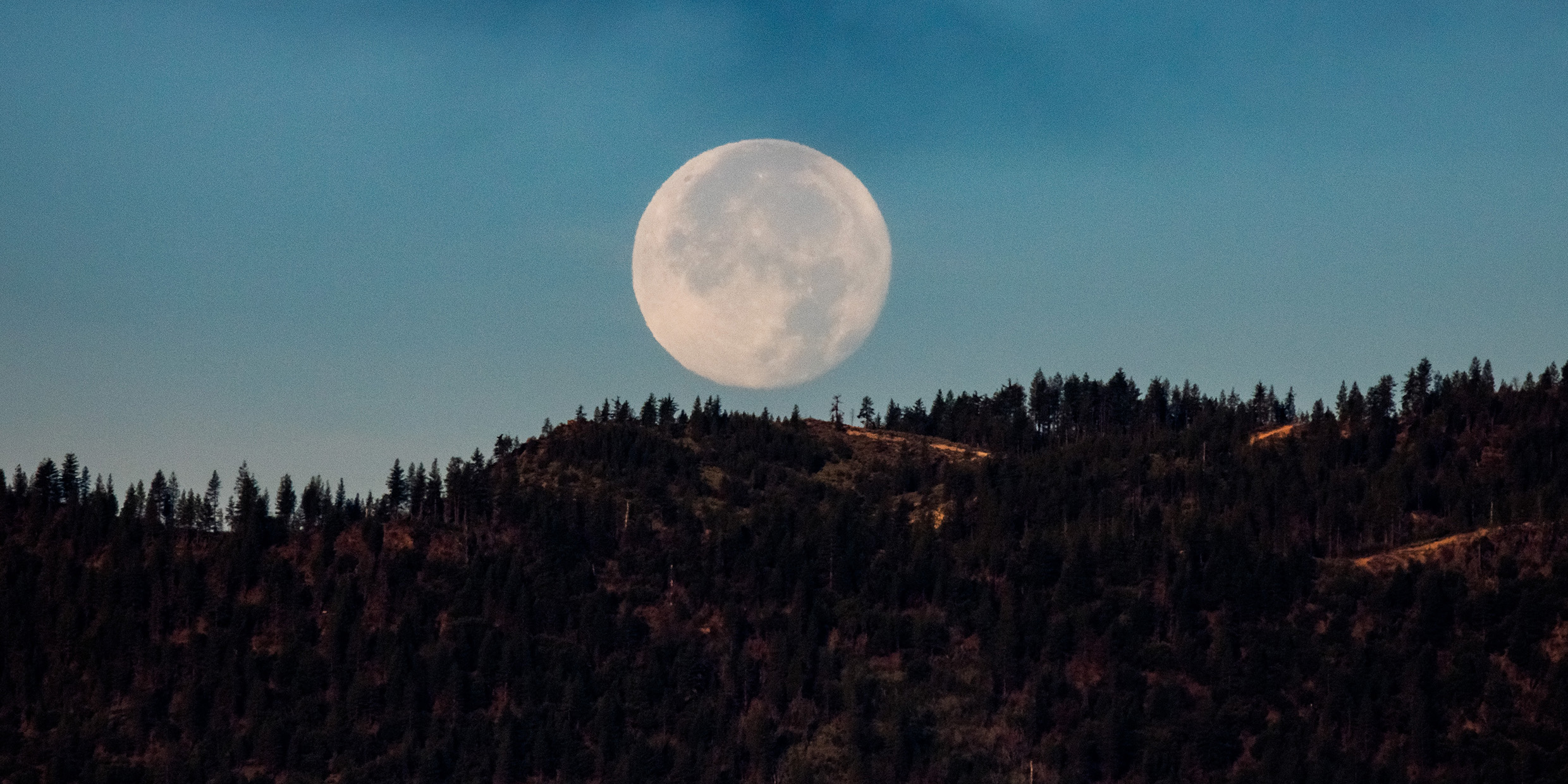Originally published 4 January 1988
Yesterday, just at sunset, the moon rose full. Tonight, if the sky is clear, a nearly-full moon will rise again — golden, majestic, and startlingly large.
Why does a rising full moon appear so big? Is it nearer to the Earth as it rises? Or does the Earth’s atmosphere act as a lens, magnifying the moon’s disk?
In fact, the moon is the same size as it rises as at any other time. The apparent enlargement is an illusion. When we see the moon in proximity to familiar objects of the horizon — trees, houses, distant hills — the mind registers its size as bigger than normal. As the moon moves higher in the sky, away from the horizon, its perceived size shrinks. The illusion is so powerful that most observers will swear that the change of size is real.
A quick test will confirm the illusion. The moon’s apparent diameter is about the same as a pencil held at arm’s length. Use a pencil to measure the diameter of the moon tonight, as it rises, and later when it is high in the sky. You will see that the size is constant.
I once supplied a particularly skeptical student with a camera, and asked her to take pictures of the full moon as it rose, and six hours later when it was high in the sky. The images on film were precisely congruent.
The horizon tricks the senses, and seems to bring the moon closer to the eye. One such illusion sticks in my mind as the most beautiful celestial happening I have ever witnessed.
Lunar illusion
Some years ago I read a description by the astronomer Guy Ottewell of a moonrise viewed through a telescope. The horizon in Ottewell’s field of view was the crest of Arizona’s Mt. Elden nine miles away. He wrote that a crescent moon rose above this magnified horizon like a “new tarnished-silver mountain budding from the range.”
In Ottewell’s telescope, the trees on the distant horizon were scaled to the size of the moon. If you sat in the branches of one of those trees, Ottewell wrote, letting his imagination conform to what he saw, “You would be looking giddily down…on the vast desert of the lunar surface, like someone in the dome of St. Peter’s staring at its floor…you could drop pennies into the craters.”
The illusion described by Ottewell was so compelling that I resolved to make the same observation for myself. It was months before everything came together: a rising third-quarter moon, a clear night, an appropriate horizon. I set up my telescope and pointed it to the place where I knew the moon would rise, on the crest of distant hills across a bay.
The half-illuminated disk of the moon rose dark-side first. The unlit face was above the ridge for long seconds before I was aware of its presence. Then, as the bright face came into view, there was a scintillation on the crest of the ridge, like a festival of bonfires and torches.
It was like the rising of a stage set, a feat of theatrics suitable for an opera. Straight up out of the ground came the screen of light — no, not straight up but angling toward the south, rising and sidling southward. The tree-lined horizon, against the moon’s face, made it seem as if I were looking down onto the lunar surface from just above, like an astronaut in orbit.
Tour of the moon
I was treated to a tour of lunar geography from what seemed a surprising nearness. First came the central highlands of the moon, the mountainous region between the eastern and western “seas,” coinciding with the divide between lunar day and night. A bright concavity in the line of ragged shadows was the eastern edge of the Sea of Serenity, rimmed by the sunlit peaks of the Haemus and Caucasus Mountains.
The Sea of Vapors disentangled itself from the horizon, and the spectacular range of the lunar Apennines came into view, their steep eastern flanks catching the light of the sun. Next, a line of prominent craters — Plato, Archimedes, Ptolemy, and Tycho.
I was out of the shadows now and above the sunlit eastern plains. This was the “wet” side of the moon — the Sea of Rains, the Sea of Moisture, the Sea of Clouds, the Sea of Storms, the Bay of Dew — not really seas and bays at all, but vast, dusty plains.
At last the full circumference of the moon’s bright circle broke free of the horizon, and I glimpsed there the dark blemish of the crater Grimaldi; if I were standing in its bowl, it would be lunar noon, the sun directly overhead.
The rising of the moon had seemed slow and ponderous, but the whole spectacular show had lasted only a minute. My telescope had somehow dilated time, even as it drew the moon closer to my eye. When I took my eye from the scope, time quickened, and the luminous globe that had seemed so near was restored to a distant dot of light.
The night I watched moonrise through a telescope, she ascended the air like the Lady of the Lake from dark water, or Titania rising from enchanted sleep — immense, golden, magical. It was the ultimate lunar illusion.



